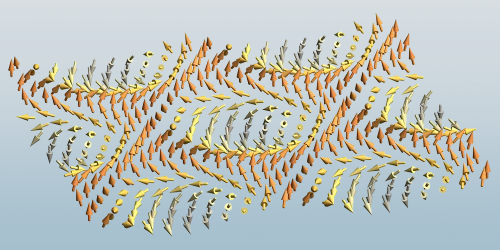Quantum Computing with a Twist
Scientists think that the performance of quantum computers could be improved by using hypothesized phases of matter known as non-Abelian states, which have the potential to encode information in an error-resistant way. But realizing a material that could host such states typically requires a powerful magnetic field, which would hinder device integration. Now three teams have predicted that non-Abelian states can form in certain semiconductor structures without a magnetic field [1–3]. If this prediction is confirmed experimentally, it could lead to more reliable quantum computers that can execute a wider range of tasks.
The three teams considered a material in which two single layers of the semiconductor molybdenum ditelluride are stacked with a slight twist between them. Using theoretical modeling and advanced simulations, the groups investigated whether this material could harbor non-Abelian states in zero magnetic field. All three teams found that these states could emerge at a twist angle of about 2° if one of the material’s energy levels called the second moiré band were half-filled with electrons.
The teams explore different aspects of this predicted phenomenon. Aidan Reddy at the Massachusetts Institute of Technology and his colleagues predict that non-Abelian states could also form in similar 2D structures involving other semiconductors [1]. Gil Young Cho at Pohang University of Science and Technology, South Korea, and his colleagues argue that the emergence of non-Abelian states may be related to similarities between the second moiré band and more conventional energy levels called Landau levels [2]. Lastly, Yang Zhang at the University of Tennessee, Knoxville, and his colleagues posted an e-print of a detailed model that explains how individual electrons behave in the twisted semiconductor bilayer [3].
Theorists have already devised ways to harness non-Abelian states as workable qubits and manipulate the excitations of these states to enable robust quantum computation.
–Ryan Wilkinson
Ryan Wilkinson is a Corresponding Editor for Physics Magazine based in Durham, UK.
References
- A. P. Reddy et al., “Non-Abelian fractionalization in topological minibands,” Phys. Rev. Lett. 133, 166503 (2024).
- C.-E. Ahn et al., “Non-Abelian fractional quantum anomalous Hall states and first Landau level physics of the second moiré band of twisted bilayer MoTe2,” Phys. Rev. B 110, L161109 (2024).
- C. Xu et al., “Multiple Chern bands in twisted MoTe2 and possible non-Abelian states,” arXiv:2403.17003.




